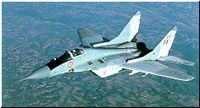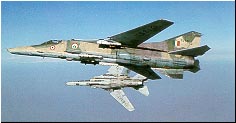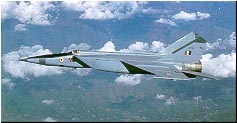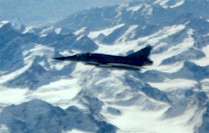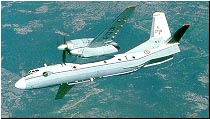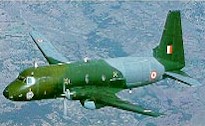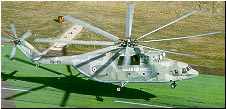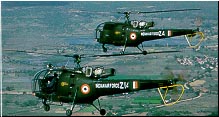|
SU-30 ~
Twin seater t |
|
| MiG-29 ~ Twin engine, single seater air superiority fighter aircraft of Russian origin capable of attaining max. speed of 2445 km per hour (Mach-2.3). It has a combat ceiling of 17 km. It carries a 30 mm cannon alongwith four R-60 close combat and two R-27 R medium range radar guided missiles. |
|
| MiG-27 ~ Single engine, single seater tactical strike fighter aircraft of Russian origin having a max. speed of 1700 km/hr (Mach 1.6). It carries one 23 mm six-barrel rotary integral cannon and can carry upto 4000 kg of other armament externally. |
|
| MiG-25 ~ Twin engine, single seater strategic reconnaissance aircraft of Russian origin having a max. speed of Mach 3.2 and max height close to 24 km unmatched by any other fighter aircraft in the world. |
|
| MiG-23 MF ~ Single engine, single seater swing wing air superiority fighter of Russian origin carrying one 23 mm twin barrel gun and two R-23R/T medium range and two R-60 close combat missiles. It has a max speed of 2446 km/hr (Mach 2.3). |
|
| MiG-21 BIS ~ Single engine, single seater multirole fighter/ground attack aircraft of Russian origin which forms the back-bone of the IAF. It has a max speed of 2230 km/hr (Mach 2.1) and carries one 23mm twin barrel cannon with four R-60 close combat missiles. |
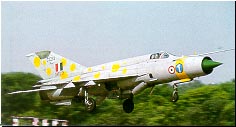 MiG-21 BIS |
| Mirage-2000 ~ A single seater air defence and multi-role fighter of French origin powered by a single engine can attain max speed of 2495 km/hr(Mach 2.3). It carries two 30 mm integral cannons and two matra super 530D medium-range and two R-550 magic II close combat missiles on external stations. |
|
| Jaguar ~ A twin-engine, single seater deep penetration strike aircraft of Anglo-French origin which has a max. speed of 1350 km /hr (Mach 1.3). It has two 30mm guns and can carry two R-350 Magic CCMs (overwing) alongwith 4750 kg of external stores (bombs/fuel). |
|
| Canberra ~ Twin engine, twin seater subsonic tactical bomber and interdictor of British origin having max speed of 933 km/hr having four integral cannons (20 mm) and capable of carrying three bombs (1000 lbs each) internally alongwith two bombs (1000 lbs) underwing or 8000 lbs bomb load internally and underwing. |
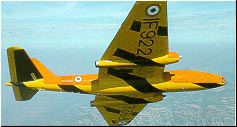 Canberra |
| IL-76 ~ A four engine heavy duty/long haul military transport aircraft of Russian origin with a max speed of 850 km/hr. It has a twin 23 mm cannon in tail turret and capacity to carry 225 paratroopers or 40 tonnes freight, wheeled or tracked armoured vehicles. |
|
| AN-32 ~ Twin engine turboprop, medium tactical transport aircraft of Russian origin with a crew of five and capacity to carry 39 paratroopers or max load of 6.7 tonnes. It has a max cruise speed of 530 km/hr. |
|
| AVRO ~ Twin engine turboprop, military transport and freighter of British origin having a capacity of 48 paratroopers or 6 tonnes freight and max cruise speed of 452 km/hr. |
|
| Dornier ~ Twin engine turboprop, logistic air support staff transport aircraft of German origin capable of carrying 19 passengers or 2057 kg freight. It has a max speed of 428 km/hr. |
|
| Boeing 737-200 ~ Twin engine turbofan, VIP passenger aircraft of American origin with total seating capacity of upto 60 passengers. It has a max cruise speed of 943 km/hr. |
|
| MI-26 ~ Twin engine turboshaft, military heavy lift helicopter of Russian origin with carrying capacity of 70 combat equipped troops or 20,000 kg payload. It has a max speed of 295 km/hr. |
|
| MI-25 ~ Twin engine turboshaft, assault and anti armour helicopter capable of carrying 8 men assault squad with four barrel 12.7 mm rotary gun in nose barbette and upto 1500 Kg of external ordnance including Scorpion anti-tank missiles. It has a max cruise speed of 310 km/hr. |
|
| MI-17 ~ Twin engine turboshaft, medium transport helicopter of Russian origin with a capacity of 24 troops or 3.3 tonnes of freight. It carries 6 UV-17, 57 mm rocket pods and has max cruise speed of 240 km/hr. |
|
| Chetak ~ Single engine turboshaft, light utility French helicopter with capacity of 6 passengers or 500 kg load. The anti-tank version carries 4 AS-11 wire guided missiles. It has a max speed of 220 km/hr. |
|
| Cheetah ~ Single engine turboshaft, FAC/casevac helicopter of French origin having capacity to carry 3 passengers or 100 kg external sling loads. It has max cruise speed of 121 km/hr and can climb to 1 km in 4 minutes. |
|

